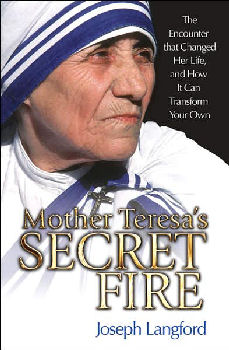
|
Posted November 23, 2008
Book: Mother Teresa’s Secret Fire: The encounter that changed her life, and how it can transform your own Author: Joseph Langford Our Sunday Visitor, Huntington, IN. 2008. Pp. 313 An Excerpt from the Jacket:
There is no better example than Mother Teresa. She continues to be a wonderful icon, a symbol of the nobility of the human spirit and every person’s capacity to do extraordinary things. At age 38, Mother Teresa broke out of her safe and reliable routine as a teacher. With only five rupees to her name, she began going daily into the slums of Calcutta. By the time of her death in 1997, her Missionaries of Charity had spread to more than 120 countries and touched millions of lives. What was it that caused this transformation? What special qualities did she have that moved her into action? How do we account for her universal impact from such extreme, humble conditions? What was it in her that touched so many so deeply? Mother Teresa’s Secret Fire provides the answers and what they mean for you. With the help of her trusted friend and co-founder of her Missionaries of Charity priests’ community, walk in the footsteps of Mother Teresa to understand the depths of her spirituality. This is the message she asked Joseph Langford to share with the world. Let her message guide you to the most neglected realms of your own spirit. Discover the inspiration, insight, and instruction to transform your everyday life in the same way Mother Teresa transformed hers. An Excerpt from the Book: For all who “have eyes to see,” there is a great light hidden here. Beyond the obvious light of Mother Teresa’s charity, there in the heart of her night lies a deeper light still. But how can light be born of darkness? This question is critical, for it is key to the process and the history of divine transformation. First, there is the creation story, in which the Almighty transformed the dark void into substance and light. There is the second creation story, where Adam and Eve are cast from a luminous Eden into a world of darkness and temptation. The Redeemer, light of the world, is heralded by a night star at his birth. The Nicene Creed sings of him as “light from light, true God from true God.” Finally, in the Resurrection, the darkness of death is conquered by his brilliance emerging from the tomb. Darkness need not be the opposite, the enemy of light. When seeded with God’s grace, darkness becomes its catalyst. Night becomes the womb to the day. It is the power of love, of God’s own nature to love, that works this alchemy. When embraced for others, when transformed by love, darkness indeed becomes light. Paradoxically, by embracing her darkness for the sake of the poor, Mother Teresa fulfilled her call — in her welcomed darkness she became God’s light. Her sacrifice shone with a light that transcends our logic. As St. Paul comments on the archetypal mystery of divine light clothed in human darkness, shining forth from Jesus’ passion and death, For Jews demand signs and Greeks seek wisdom, but we preach Christ crucified, a stumbling block to Jews and folly to Gentiles, but to those who are called, both Jews and Greeks, Christ the power of God and the wisdom of God. This crucified light, so utterly “other” that it seems to us darkness and scandal, is the refulgence of God’s self-emptying love. Divine love wraps itself in our pain and darkness, as Mother Teresa would say, “without counting the cost.” God’s very nature as love plunges him headlong inot our neediness and, unbelievably, even into our sin. In St. Paul’s bold words: “For our sake he made him to be sin who knew no sin. Mother Teresa would follow Jesus’ lead. She, who from childhood knew no darkness, would accept to “become darkness” for the sake of the poor. She gathered into her soul and flooded with love the very blackness that denied God’s existence, drowning the darkness in light. The importance of Mother Teresa’s example, even for those who bear much milder Calcuttas, is in showing how far faith and love can reach in this life — even in the night, even buffeted by pain, with every wind against it. Her victory in the night is proof that the exercise of faith and love is ultimately our free choice, never beholden to circumstance, a decision accessible at all times. God makes it always possible to move beyond preoccupation with our own pain, and to reach out to assuage the pain of others. Rather than isolating us, we can choose to make of life’s burdens a sacred bridge into the pain of others. Table of Contents: I. One: Fire in the night 1. Why Mother Teresa? 2. A life bathed in light 3. Calcutta: backdrop to an Epiphany 4. A message discovered 5. In her own words II. Illumination 6. In the darkness, light 7. “I thirst”: a window on the heart of God 8. A legacy of light 9. A legacy of light Part II 10. Meditation: entering the light III. Transformation 11. The power to change 12. The beauty of God within 13. Encounter: seeking his face 14. Secret fire 15. Drawn into the light 16. Naming the darkness, choosing the light 17. Conversion: thirsting for God 18. Joining the thirst of God and man Conclusion |
|
